p.548
p.554
p.559
p.565
p.569
p.575
p.581
p.586
p.590
Towards an Application of PBD Principles for Innovative Recentering Beam-to-Column Connections
Abstract:
An unintended consequence is that some freedom in the introduction of innovative composite connections has been removed. The innovative aspects of this connection are in the use of partial restraint connections between steel beams and concrete-filled tube columns that utilize a combination of low-carbon steel and shape memory alloy components. A refined finite element model with sophisticated three dimensional solid elements was developed to conduct numerical experiments on the proposed joints to obtain the global behavior of the connection and develop simplified models. The paper argues that careful analytical studies can replace the requirement for physical testing present in current steel codes.
Info:
Periodical:
Pages:
569-574
Citation:
Online since:
July 2013
Authors:
Price:
Сopyright:
© 2013 Trans Tech Publications Ltd. All Rights Reserved
Share:
Citation:


